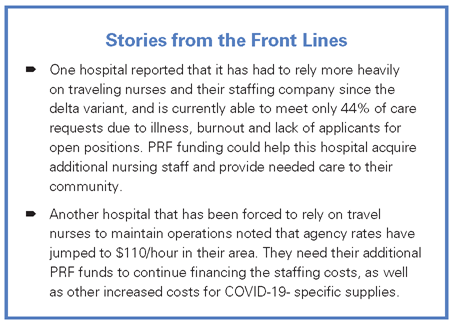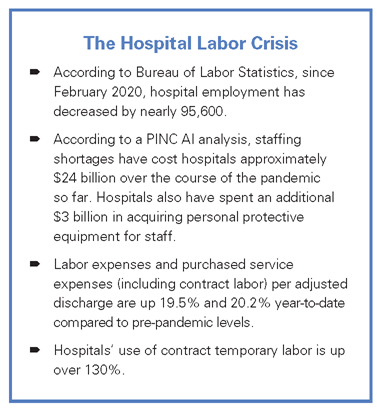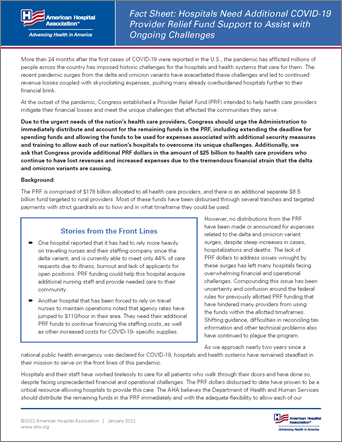Fact Sheet: Hospitals Need Additional COVID-19 Provider Relief Fund Support to Assist with Ongoing Challenges
January 2022
More than 24 months after the first cases of COVID-19 were reported in the U.S., the pandemic has afflicted millions of people across the country has imposed historic challenges for the hospitals and health systems that care for them. The recent pandemic surges from the delta and omicron variants have exacerbated these challenges and led to continued revenue losses coupled with skyrocketing expenses, pushing many already overburdened hospitals further to their financial brink.
At the outset of the pandemic, Congress established a Provider Relief Fund (PRF) intended to help health care providers mitigate their financial losses and meet the unique challenges that affected the communities they serve.
Due to the urgent needs of the nation’s health care providers, Congress should urge the Administration to immediately distribute and account for the remaining funds in the PRF, including extending the deadline for spending funds and allowing the funds to be used for expenses associated with additional security measures and training to allow each of our nation’s hospitals to overcome its unique challenges. Additionally, we ask that Congress provide additional PRF dollars in the amount of $25 billion to health care providers who continue to have lost revenues and increased expenses due to the tremendous financial strain that the delta and omicron variants are causing.
Background:
The PRF is comprised of $178 billion allocated to all health care providers, and there is an additional separate $8.5 billion fund targeted to rural providers. Most of these funds have been disbursed through several tranches and targeted payments with strict guardrails as to how and in what timeframe they could be used.
 However, no distributions from the PRF have been made or announced for expenses related to the delta and omicron variant surges, despite steep increases in cases, hospitalizations and deaths. The lack of PRF dollars to address issues wrought by these surges has left many hospitals facing overwhelming financial and operational challenges. Compounding this issue has been uncertainty and confusion around the federal rules for previously allotted PRF funding that have hindered many providers from using the funds within the allotted timeframes. Shifting guidance, difficulties in reconciling tax information and other technical problems also have continued to plague the program.
However, no distributions from the PRF have been made or announced for expenses related to the delta and omicron variant surges, despite steep increases in cases, hospitalizations and deaths. The lack of PRF dollars to address issues wrought by these surges has left many hospitals facing overwhelming financial and operational challenges. Compounding this issue has been uncertainty and confusion around the federal rules for previously allotted PRF funding that have hindered many providers from using the funds within the allotted timeframes. Shifting guidance, difficulties in reconciling tax information and other technical problems also have continued to plague the program.
As we approach nearly two years since a national public health emergency was declared for COVID-19, hospitals and health systems have remained steadfast in their mission to serve on the front lines of this pandemic.
Hospitals and their staff have worked tirelessly to care for all patients who walk through their doors and have done so, despite facing unprecedented financial and operational challenges. The PRF dollars disbursed to date have proven to be a critical resource allowing hospitals to provide this care. The AHA believes the Department of Health and Human Services should distribute the remaining funds in the PRF immediately and with the adequate flexibility to allow each of our nation’s hospitals to overcome its unique challenges. In addition, Congress should add $25 billion to the PRF to provide support to address the new challenges caused by the delta and omicron variants.
Since PRF funds were first allocated, COVID-19 cases, hospitalizations and deaths have increased exponentially while patient volumes have been sluggish to recover to pre-pandemic levels.
- COVID-19 hospitalizations have increased by over 800,000 in just the last two months, with a total of nearly 4.2 million cumulative COVID-19 hospitalizations since August 2020.
- The seven-day average of new COVID-19 hospital admissions has increased by 225% over the last two months and reached a peak seven-day average of 21,606 COVID-19 admissions in early January 2022 amid the current omicron surge.
- As of December 2021, patient discharges and adjusted discharges are down 5.9% and 5.5%, respectively, compared to pre-pandemic levels. Emergency department visits also are down 8.3% compared to pre-pandemic levels.
 With the slow recovery of patient volumes, revenue losses have continued to mount, while expenses have grown significantly compared to pre-pandemic levels.
With the slow recovery of patient volumes, revenue losses have continued to mount, while expenses have grown significantly compared to pre-pandemic levels.
- Rising expenses are an immediate and growing concern for hospitals as they attempt to remain solvent. On a per-adjusted discharge basis, total hospital expenses are up 10.6% year-to-date compared to 2019.
- One of the drivers of higher expenses is increased patient acuity. Average patient length-of-stay is up 8.8% year-to-date compared to pre-pandemic levels.
- Another contributor to higher hospital expenses that is of growing concern is the increase in violence against health care workers. While the incidence of violence against health care workers has been rising over the last decade, it has accelerated and gained greater prominence during the COVID-19 pandemic. This issue has contributed to the rise in labor and other expenses as a result of low staff morale leading to high turnover rates and additional expenses associated with security measures and training.


